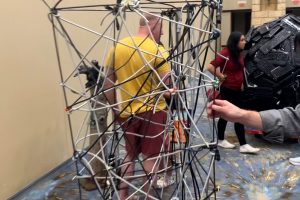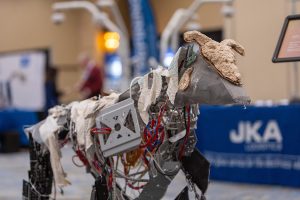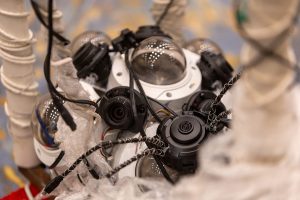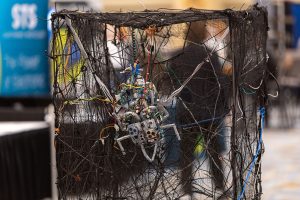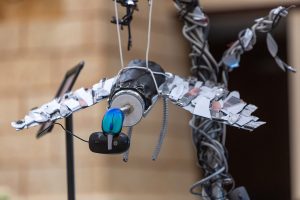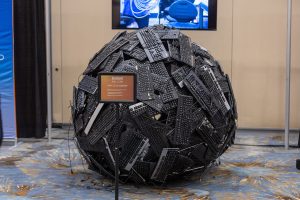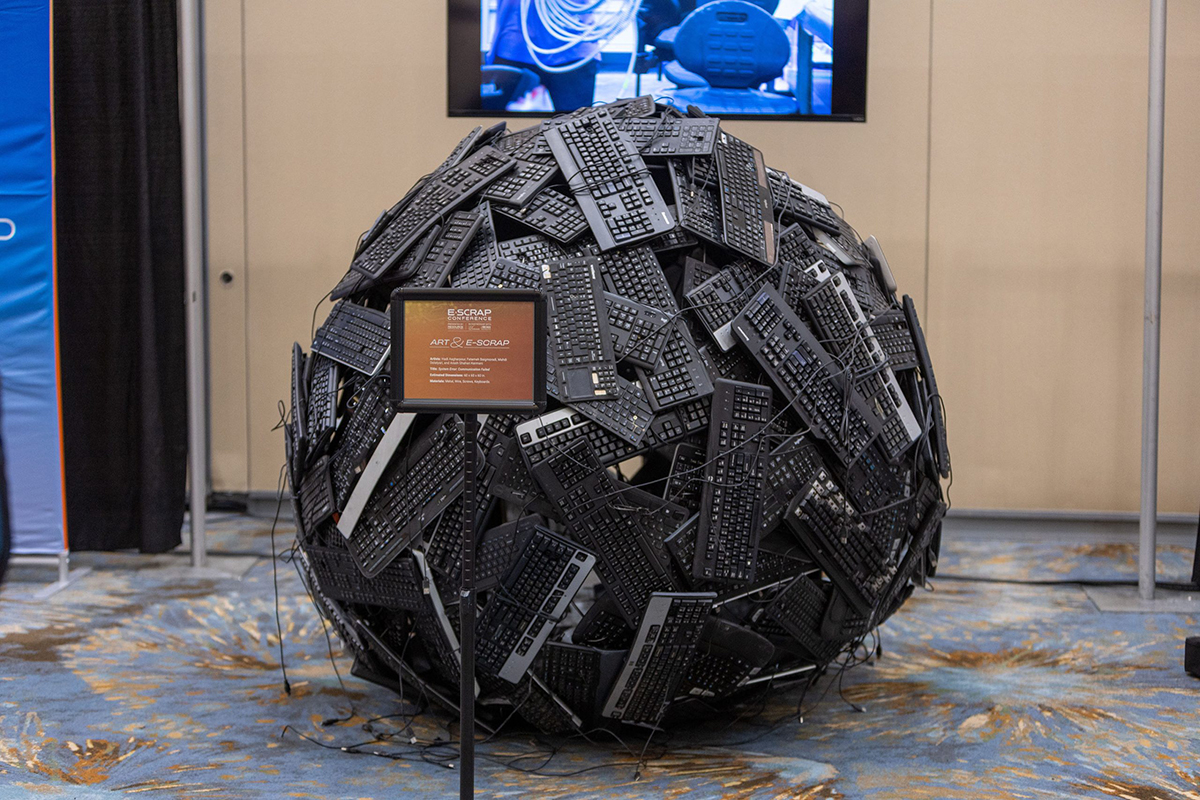
UT Dallas students in S. V. Randall’s program turned donated e-scrap from HOBI International into sculptures at E-Scrap 2025, exploring reuse, scrap and renewal. | Photo by Big Wave Productions
At the E-Scrap Conference in Grapevine, Texas, a small exhibit drew steady foot traffic and long pauses as students turned retired keyboards, cables and computer components into sculptures that reflected reuse and responsibility.
The installation, “Art & E-Scrap,” came together through professor S. V. Randall’s sustainable arts practice course in the Harry W. Bass Jr. School of Arts, Humanities and Technology at the University of Texas at Dallas.
“All the materials were donated by HOBI International,” Randall said, referring to the Dallas company that focuses on electronics recycling and IT asset disposition. “[It’s] super exciting and a really incredible turnout in terms of the students that participated. We have been working for the last maybe three to four weeks, where students started from scratch, welding basic armatures and attaching them using a variety of different methods.”
The most imposing piece was a black sphere of keyboards about five feet tall, built by a four-person grad team led by Arash Ghahari, a PhD candidate who also teaches sculpture. “We had basically two main goals,” Ghahari said. “To make something that is pointing towards a recycling theme, which is how we chose the circle form or the sphere. It also is a symbol for the globe.”
The team titled the work “System Error: Communication Failed.” “Keyboards being devices that are very good symbols for communication these days, we wanted to nod to how convoluted communication and chaotic information can get.”
Ghahari credited teammates Hadi Asgharpour, Fatemeh Baigmoradi and Mahdi Dolatyari, and described a welded steel frame under the keys. The group used wires and screws to secure what he estimated as slightly more than 100 keyboards.
In fact, to any seasoned fan of science-fiction, the sculpture looked like something that might have come from the minds of Charlie Brooker or even William Gibson, the author credited with creating the sub-genre of cyberpunk. Sadly, however, word of their contributions to the fictional future where grit meets glitch hadn’t filtered down to the students in professor Randall’s class, so who knows what might happen when they have read “Neuromancer” or watched “Black Mirror.”
Stephany Chan installed a cable-tied triangle that plays with tension and restraint for her piece that she called “Wireles Triengl.” She described the idea as a response to overproduction and overconsumption. “At times I thought about hot gluing, but I was like, I don’t think that speaks as much as tying a knot,” she said. “Because the thing about a knot, it can be undone, but it does require some work.” A working title circled around the idea of untying a knot, she added.
Michele Pomella collaborated with Parul Bhatia on a figurative piece titled “Old Lady.” “HOBI International let us come in and pick out anything,” Pomella said. “It was exciting. In school you usually do school projects. You don’t usually branch out to something as public as this.” The pair experimented with metal and wood, letting the recovered materials drive form and finish.
Randall said course readings include Linda Weintraub’s “To Life,” which surveys artists working with environmental themes, but he noted the students took the brief and pushed it through their own lenses. “I was surprised how anthropomorphic the work felt,” he said. “Animals and humans made out of plastic and metal scrap.”
Conference attendees asked about methods, materials and meaning and at least one piece was reportedly sold during the showcase, although the exact price has not yet been officially confirmed. For the students, the room offered a different audience from a classroom critique, one filled with processors, ITAD leaders and refurbishers who usually see these objects at the other end of their life cycle.
The exhibit’s premise was simple, but the effect was cumulative. As one artist put it, one company’s end of life can be another beginning, and sometimes the knot can be undone if you put in the work. Attendees of E-Scrap 2025 were able to vote on which piece they liked the most by way of a poll that was part of the cellphone app. The winners, in a tied first-place position, were “System Error: Communication Failed” by Hadi Asgharpour, Fatemeh Baigmoradi, Mahdi Dolatyari and Arash Ghahari Kermani and “Wild Transmission” by Paul Monaco.
- “Electra” – Artists: Parul Bhatia and Michele Pomella | Photo: Big Wave Productions
- “Wireles Triengl” – Artist: Stephany Chan | Photo: Big Wave Productions
- “Camouflage” – Artists: Gabrielle Geppert, Jared Selke and Jay Whitaker | Photo: Big Wave Productions
- “Speyeder Estimated” – Artists: Gabriel Hernandez Gonzales and Jade Ju-Young Jeong | Photo: Big Wave Productions
- “Caught in the Web” – Artist: Bianca Marquez | Photo: Big Wave Productions
- “Wild Transmission” – Artist: Paul Monaco | Photo: Big Wave Productions
- “Infestation” – Artists: Tyler Peterson and Kaitlyn Van Nice | Photo: Big Wave Productions
- “System Error: Communication Failed” Artists: Hadi Asgharpour, Fatemeh Baigmoradi, Mahdi Dolatyari and Arash Ghahari Kermani | Photo: Big Wave Productions



